Siphon pot the principle and origin of siphon pot

Siphon pot (Siphon), commonly known as "plug wind pot" or "siphon", is a simple and easy-to-use method of coffee brewing, and it is also one of the most popular coffee brewing methods in cafes. Many people like the precision of siphon cooking with a touch of laboratory flavor, watching the water boil up and the coffee extracted into black drops, step by step in the hands of the coffee brewer. Using an Italian coffee maker often leaves part of the process to a machine, and siphon coffee seems to satisfy some people who like to do-it-yourself DIY.
The production principle is that the water is heated to produce water vapor, causing hot expansion and cold shrinkage, pushing the hot water from the lower pot to the upper pot, and then sucking back the water from the upper pot after the lower pot cools.
In 1840, a laboratory glass test tube pulled the siphon coffee maker (Siphon) invention trigger, Scottish Navy engineer Robert. Robert Napier created the first vacuum coffee pot based on a test tube for chemical experiments. Two years later, Mrs. Vasser of France improved the pot, and the familiar upper and lower convection siphon pot was born. The siphon coffee maker lived in France for a long time, but never got a good chance to be very popular.

(the Royal Belgian Coffee Pot, also known as the balanced plug Coffee Pot, the imperial coffee pot of European royalty in the middle of the Balancing Siphon,19 century)
It became popular for the first time when it was brought to Denmark and Japan in the mid-20th century.
Aestheticist Danes pay attention to functional design, Peter, who imported siphon pots from France in the mid-1950 s. Bolton (Peter Bodum), who thought French-made pots were expensive and difficult to use, partnered with architect Kaas Klaeson to develop Bodum's first styling siphon pot, which went public under the name "Santos".
(Bodum Santos coffee maker)
The Japanese like the "tortoise hair" personality of the siphon pot technology standard, carefully deliberating the complex relationship between the size of coffee powder, water and time to mobilize the whole army, and develop a well-regulated coffee path.

(common Japanese siphon pot)
Siphon coffee maker always has a hint of mystery in most people's impression. Siphon coffee maker plays an important role in the history of coffee development in Taiwan. In recent years, so-called ground coffee (Italian espresso) has become very popular. In comparison, this siphon coffee maker requires higher technology and more cumbersome procedures. In today's industrial and commercial society, there is a tendency to decline gradually, but the mellow flavor of coffee brewed by siphon coffee pot can not be compared with ground coffee brewed by machine. Let's take a look at the production method.
Important Notice :
前街咖啡 FrontStreet Coffee has moved to new addredd:
FrontStreet Coffee Address: 315,Donghua East Road,GuangZhou
Tel:020 38364473
- Prev

Recommendation of Italian coffee machine for household coffee utensils
Today, when the concept of coffee has gradually spread to thousands of households, many people also want to taste the delicacy that they can only drink in a coffee shop at home, and can fully enjoy the fun brought by coffee DIY. However, in terms of the choice of coffee utensils, many people are also confused about what kind of utensils should be chosen. So in this article, I would like to recommend some practical appliances.
- Next

Aeropress (Aeropress) is born. Aeropress Introduction
AeroPress was officially released in 2005 by AEROBIE, USA. It has been listed and aroused strong response for its advantages of easy use, high efficiency and delicious coffee. The new coffee maker was invented by Stanford University mechanical engineering lecturer Alan Adler, who holds more than 40 patents in the United States and other countries. Ale press is a hand-brewed coffee jane
Related
- What is the Philharmonic pressure? How to use Philharmonic pressure to make delicious coffee
- Why does a hand grinder have more fine powder than an electric grinder?
- In addition to the hot mom, what is the difference between the versions of EK43 | ditting and Mahdi ek43?
- What kind of equipment do you need to make coffee by hand? Introduction to novice starter cooking equipment tools
- Espresso needs to be ground how thick and thin scale entry Italian Coffee Machine Bean Grinder investigation and Grinding course
- How much does it cost to open a small private cafe? How much does it cost to learn coffee? How to operate it?
- The difference between the flavor characteristics of hand-brewed coffee and coffee maker is hand-brewed coffee really better than coffee maker? Can I use a coffee machine to make coffee beans by hand?
- The difference between 01 and 02 of hario v60 filter cup what is the difference between 01 and 02 filter cup opening and cooking flavor
- What's the difference between the smart cup and the French kettle? Which is better, the French kettle or the Smart Cup?
- What's the difference between a smart cup and a V60 filter cup? The difference between the taste of smart cup and hand-brewed coffee

